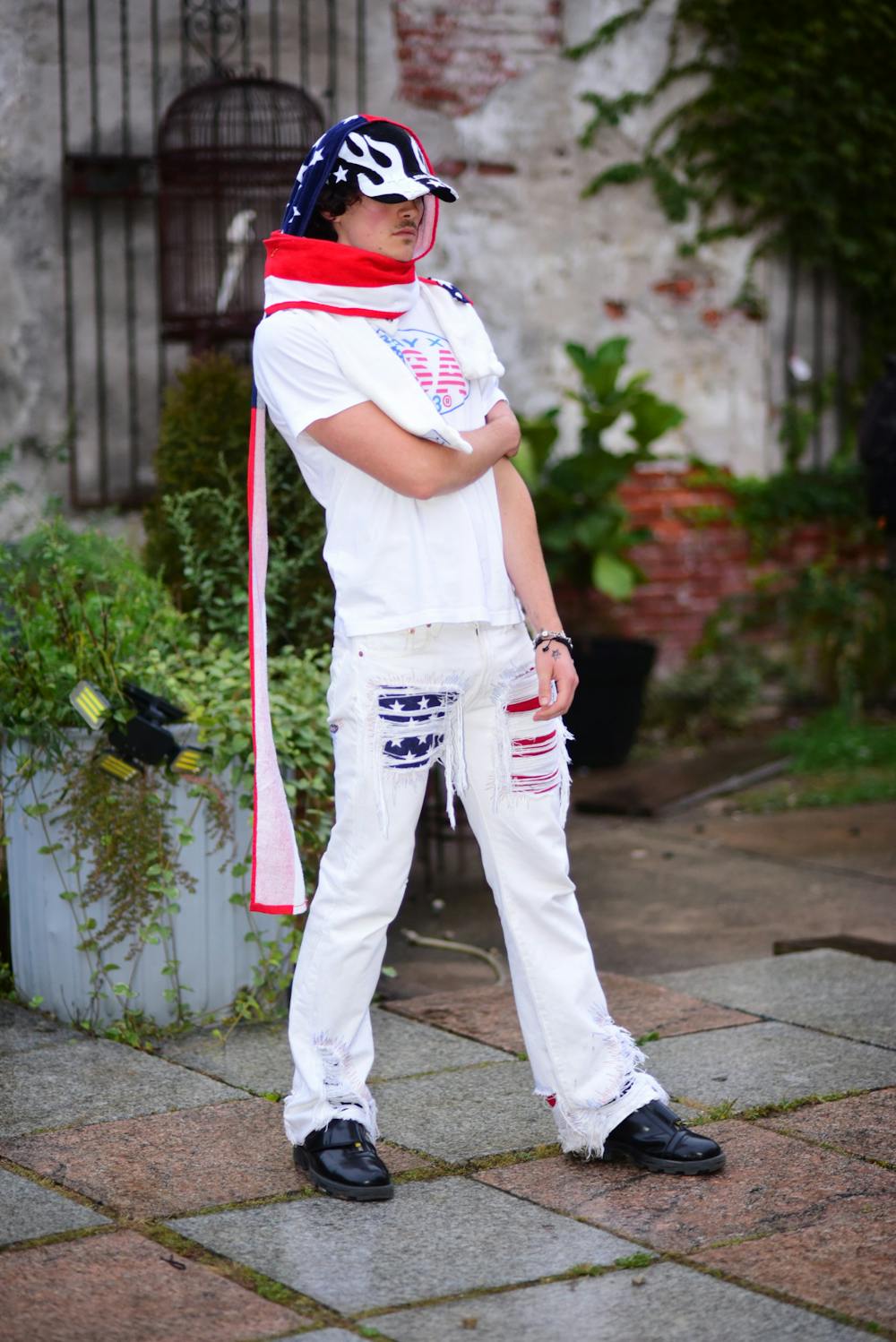It’s drizzling rain outside in The Sculpture Courtyard, a mixed indoor–outdoor event space in Northeast Philadelphia. Murmurs, fragments of conversation mix with the icy and distorted synths of “Hedphrlym,” an ambient techno song. Guests walk by in military boots, colorful patchwork jackets, layers of silver punk chains. Here, on a Friday night, unique characters and personalities reveal themselves, liberated from the rules and normalities of daily life in Philadelphia. It’s a new, alien world, one defined by both individual self expression and a strong sense of community. This is not the “land of the free” anymore, it’s the Land of the Free(ks) fashion show.
This world is the vision of Philadelphia native Melasia Pinder, the twenty six year old entrepreneur/graphic designer/artist behind Almost Famous, a popular event series that has become a beacon for Philly’s arts community.
Having graduated in 2020 from Philadelphia University (now Thomas Jefferson University, after a recent merger) with a degree in fashion merchandising, in the middle of a global pandemic, Pinder found herself in need of both human interaction and job prospects. Her first Almost Famous pop up shop event, held on Juneteenth, 2021, was her solution to both of these problems.
“I was always an entrepreneur, and I always saw myself doing my own projects. I also wanted to give back to the community, so Almost Famous kind of burst out of that.” Having put on smaller events before, and been involved in the Philly arts community for years, Pinder says the event felt like a natural progression. “Although it was my first large public event, it felt right. I mean, the turnout was something that I had already envisioned.” There were over 400 people at the first pop up shop, she says. “It felt good, it felt real. It felt like I had brought an idea to life.”
A few months ago, after a streak of successful pop up events, Pinder decided it was time to fulfill her dream of putting on a fashion show. However, she wanted her event to be different from a typical runway show. “I went to a New York fashion week and didn’t like the culture around me. It felt like people labeled you as less than just because they were making more money than you or working for an important brand.”

Hoping to avoid this type of culture, she set out to create a show that promotes community instead of elitism. The name Land of the Free(ks) was devised out of a desire to both criticize and celebrate American fashion and culture. “I just wanted to shed light on what America, at least from my point of view, looks like. It does not look like the polished, whitewashed, perfect American dream fantasy that we portray ourselves to be. It looks gritty. It looks like a constant fight for change, a constant fight for freedom, and a constant fight to be, to remain uniquely comfortable in one’s given environment.”
In choosing the designers for the show, Pinder wanted a “diverse set of people” that represent the “real America.” Gathered from an online casting call, she felt these seven designers' clothes best reflected her concept for a “different, unique, out of the ordinary, taboo, non traditional” show, while also prioritizing Black creative voices.
One of the designers, Muhktar Stones, affectionately nicknamed Uncle Muk by friends and family because of his “old soul” and thoughtful insight, is a twenty four year old visual and tattoo artist from Philly who fully embraces the “freak” part of the fashion show with his designs. One of his models, his brother Eli, wearing a spiked black ski mask and gray sweatsuit, squats and shuffles across the runway, screaming and grunting like a wild animal while waving a hammer in the air. “Before the show I was just telling him just to act like a fucking lunatic. And I was like, yeah, get in people's faces if you want, and intimidate people. I wanted my aspect of the runway to be immersive,” Stones says.
His designs are instantly recognizable due to his signature fabric spikes, which are incorporated into almost all of his clothing. These large, often colorful spikes seem to evoke the spirit of 2000s–era Cartoon Network, making his models look like some kind of fashionable Pokemon, each with their own unique traits and attack abilities. To complement this cartoonish style, Stones adds a collection of unique accessories to his outfits: swords, Willy Wonka glasses, and the hot dog finger gloves from Everything Everywhere All at Once.
The wildest accessory piece is a set of angel wings made out of overlapping metal blades. “I got most of those swords at comic book conventions when I was younger,” he says. “I'm just a geek when it comes to stuff like that.” Stones also geeks out when it comes to anime (he mentions Samurai Champloo and Ninja Scroll as some of his favorites), and one of his looks for the show stands out as particularly anime–influenced. This model walks down the runway smoking a cigarette with one hand, and holds a samurai sword in the other. He wears a cowboy hat and an extremely cropped, unbuttoned jacket, which is accented with small spikes. The outfit evokes the genre–bending combinations of Japanese culture, American Westerns, and sci-fi found in anime like Cowboy Bebop.
“I’ve always been proud of the things I’m into and I’m not afraid to show them. I've always been myself and I wasn't afraid to be myself and so a lot of my inspirations came from just reading comic books, watching cartoons, reading manga, anime, movies,” Stones says. “I liked anything that was just creative and weird.” Stones, who sees himself as primarily a visual artist, just held his first solo exhibition for his mixed–media artwork on October 21st; the collection is called “PSYKOPOP.”
In the future, Pinder hopes to organize more fashion shows, work with more designers, and expand the Almost Famous brand. As of now, she does all of the work behind planning these events, along with her partner Shemar Pierre, a rapper and DJ for the fashion show, but she hopes to hire additional event planners which would allow her to organize more events and bring Almost Famous to new cities. She mentions a recent trip to Cleveland, Ohio, where she was surprised to find a thriving artistic community much like her own in Philly. “People don’t think of cities like Philadelphia as centers of art and fashion but we have a whole community that’s thriving, and other cities do too.”
While independent fashion designers in Philly continue to feel like “freaks,” hidden in the dark, far away from the fashion mainstream, Almost Famous acts as a spotlight for these creators, providing a sense of community and giving them their much deserved flowers.

